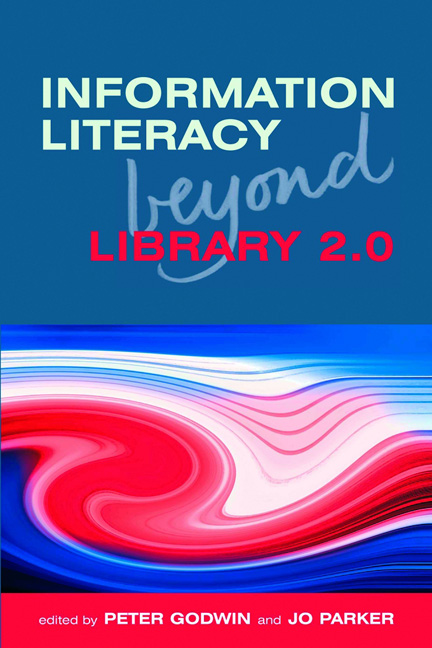Book contents
- Frontmatter
- Contents
- Contributors
- Acknowledgements
- Introduction
- PART 1 RECENT DEVELOPMENTS IN INFORMATION LITERACY AND LIBRARY 2.0
- PART 2 CASE STUDIES
- 7 Reinventing information literacy at UTS Library
- 8 Using games as treatments and creative triggers: a promising strategy for information literacy
- 9 Changing the conversation: introducing information literacy to a generation of smartphone users
- 10 Tweets, texts and trees
- 11 Referencing in a 2.0 world
- 12 Moving information literacy beyond Library 2.0: multimedia, multi-device, point-of-need screencasts via the ANimated Tutorial Sharing Project
- 13 Informed cyberlearning: a case study
- 14 An online course on social media for student librarians: teaching the information skills and literacies of social media
- 15 Transliteracy and teaching what they know
- 16 ANCIL: a new curriculum for information literacy: case study
- 17 TeachMeet: librarians learning from each other
- PART 3 WHAT IT MEANS FOR INFORMATION PROFESSIONALS
- Index
15 - Transliteracy and teaching what they know
from PART 2 - CASE STUDIES
Published online by Cambridge University Press: 09 June 2018
- Frontmatter
- Contents
- Contributors
- Acknowledgements
- Introduction
- PART 1 RECENT DEVELOPMENTS IN INFORMATION LITERACY AND LIBRARY 2.0
- PART 2 CASE STUDIES
- 7 Reinventing information literacy at UTS Library
- 8 Using games as treatments and creative triggers: a promising strategy for information literacy
- 9 Changing the conversation: introducing information literacy to a generation of smartphone users
- 10 Tweets, texts and trees
- 11 Referencing in a 2.0 world
- 12 Moving information literacy beyond Library 2.0: multimedia, multi-device, point-of-need screencasts via the ANimated Tutorial Sharing Project
- 13 Informed cyberlearning: a case study
- 14 An online course on social media for student librarians: teaching the information skills and literacies of social media
- 15 Transliteracy and teaching what they know
- 16 ANCIL: a new curriculum for information literacy: case study
- 17 TeachMeet: librarians learning from each other
- PART 3 WHAT IT MEANS FOR INFORMATION PROFESSIONALS
- Index
Summary
Introduction
University students are surprisingly adept at finding information; only, it isn't usually the kind of information that concerns their instructors. From using Wikipedia to learn about their favourite pop-singer's time in primary school, to finding health information in Yahoo! Answers, to evaluating mobile phones based on Amazon user reviews, students appeal to a range of Web 2.0 information resources in their personal lives. Yet these same students are perplexed by library resources. Keywords? Abstracts? Boolean searching? Why does it have to be so hard? At the University of Tennessee at Chattanooga, the instruction team at the Lupton Library has decided to address this disconnect head on and make students’ pre-existing search behaviours an integral part of library instruction. Rather than focus on the differences between scholarly and popular research, we focus on the similarities. Our approach draws heavily upon the concept of transliteracy.
What is transliteracy?
The concept of transliteracy has its roots in the Transliteracies Project, an interdisciplinary collective of scholars from the University of California-Santa Barbara dedicated to studying the myriad ways in which online reading has complicated traditional conceptions of literacy (http://transliteracies.english. ucsb.edu). Shortly after the inaugural 2005 Transliteracies Conference, Professor Sue Thomas of De Montfort University adapted the concept in a more generalized form as the core area of enquiry for the Production and Research in Transliteracy (PART) group. This working group is actively enquiring into the impact of new technologies on the broader notion of literacy as a communicative skill. The PART working definition of transliteracy is, at this point, the most commonly cited one. Accordingly, ‘transliteracy’ is defined as ‘the ability to read, write and interact across a range of platforms, tools and media from signing and orality through handwriting, print, TV, radio and film, to digital social networks’ (Thomas et al., 2007).
In this sense, transliteracy is not simply about the canonical sense of literacy qua reading and writing. Transliteracy takes a holistic view of the increasingly proliferating means of communication at our disposal and it focuses on the cognitive abilities inherent in transferring meaning between communication systems. From the intersubjectivity of social media tools to the intertextuality of Web 2.0 mash-ups, to new frontiers in immersive storytelling, the digital environment – and especially the Web 2.0 paradigm – has led to a distribution of literacy skills across a multiplicity of media options.
- Type
- Chapter
- Information
- Information Literacy Beyond Library 2.0 , pp. 163 - 170Publisher: FacetPrint publication year: 2012

